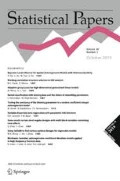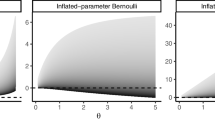Abstract
Consider a generalized random coefficient AR(1) model, \(y_t=\Phi _t y_{t-1}+u_t\), where \(\{(\Phi _t, u_t)^\prime , t\ge 1\}\) is a sequences of i.i.d. random vectors, and a conditional self-weighted M-estimator of \(\textsf {E}\Phi _t\) is proposed. The asymptotically normality of this new estimator is established with \(\textsf {E}u_t^2\) being possibly infinite. Simulation experiments are carried out to assess the performance of the theory and method in finite samples and a real data example is given.



Similar content being viewed by others
References
Araveeporn A (2017) Comparing random coefficient autoregressive model with and without autocorrelated errors by Bayesian analysis. Stat J IAOS 33:537–545
Davis RA, Knight K, Liu J (1992) M-estimaton for autoregressions with infinite variance. Stoch Proc Appl. 40:145–180
Dielman TE (1992) Misspecification in random coefficient regression models: a Monte Carlo simulation. Stat Pap 33(1):241–260
Hwang SY, Basawa IV (1997) The local asymptotic normality of a class of generalized random coefficient autoregressvie processes. Stat Probab Lett 34:165–170
Hwang SY, Basawa IV (1998) Parameter estimation for generalization random coefficient autoregressive processes. J Stat Plan Inference 68:323–337
Jürgens U (1985) The estimation of a random coefficient AR(1) process under moment conditions. Statis Hefte 26(1):237–249
Ling S (2005) Self-weighted least absolute deviation estimation for infinite variance autoregressive models. J R Stat Soc B 67(3):381–393
Mikosch T, Gadrich T, Kluppelberg C, Adler RJ (1995) Parameter estimation for ARMA models with infinite variance innovations. Ann Stat 23:305–326
Nicholls DF, Quinn BG (1982) Random coefficient autoregressive models: an introduction, vol 11. Lectures notes in statistics. Springer, New York
Pan J, Wang H, Yao Q (2007) Weighted least absolute deviations estimation for ARMA models with infinite variance. Econ Theory 23:852–879
Tong H (1990) Nonlinear time series. Oxford University Press, Oxford
Wang X, Hu S (2017) Asymptotics of self-weighted M-estimators for autoregressive models. Metrika 80:83–92
Yu C, Deng M, Yau SST (2011) DNA sequence comparison by a novel probabilistic method. Inf Sci 181(8):1484–1492
Zhao Z, Wang D (2012) Statistical inference for generalized random coefficient autoregressive model. Math Comput Model 56:152–166
Zhao Z, Liu Y, Peng C (2018) Variable selection in generalized random coefficient autoregressive models. J Inequal Appl 2018(1):82
Zhao Z, Wang D, Peng C (2013) Coefficient constancy test in generalized random coefficient autoregressive model. Appl Math Comput 219:10283–10292
Zhang L, Yu C, Sun JQ (2015) Generalized Weierstrass–Mandelbrot function model for actual stocks markets indexes with nonlinear characteristics. Fractals 23(02):1550006
Zhang Y, Yang XY (2010) Limit theory for random coefficient first-order autoregressive pocess. Commun Stat-Theory M 39:1922–1931
Acknowledgements
The authors thank the referees for pointing out some errors in a previous version, as well as for several comments that have led to improvements in this work.
Author information
Authors and Affiliations
Corresponding author
Additional information
Publisher's Note
Springer Nature remains neutral with regard to jurisdictional claims in published maps and institutional affiliations.
Project supported by Zhejiang Provincial Natural Science Foundation of China (No. LY17A010004) and First Class Discipline of Zhejiang-A (Zhejiang Gongshang University-Statistics)
Appendix
Appendix
In this Appendix, the proof of Theorem 2.1 is exhibited. We first give two lemmas, which will be used frequently in the proof. The first lemma is directly taken from Davis et al. (1992).
Lemma A.1
Let \(\{V_n(\cdot )\}\) and \(V(\cdot )\) be stochastic process on\(R^p\) and suppose that \(V_n(\cdot ){\mathop {\rightarrow }\limits ^{d}}V(\cdot )\) on \(C(R^p)\). Let \(\xi _n\) minimize \(V_n(\cdot )\) and \(\xi \) minimize \(V(\cdot )\). If \(V_n(\cdot )\) is convex for each n and \(\xi \) is unique with probability one, then \(\xi _n{\mathop {\longrightarrow }\limits ^{d}}\xi \) on \(R^p\).
Lemma A.2
Under the conditions of Theorem 2.1, we have, as \(n\rightarrow \infty ,\)
-
(i)
\(\frac{1}{n}\sum _{t=1}^n(w_t y_{t-1}^2){\mathop {\rightarrow }\limits ^{p}} \kappa ,\frac{1}{n}\sum _{t=1}^n(w_t^2 y_{t-1}^2){\mathop {\rightarrow }\limits ^{p}} \upsilon \);
-
(ii)
\(\max _{1\le t\le n}\frac{|w_t y_{t-1}|}{\sqrt{n}}{\mathop {\rightarrow }\limits ^{p}} 0\);
-
(iii)
\(\frac{1}{\sqrt{n}}\sum _{t=1}^n(w_t y_{t-1} \psi (u_t)){\mathop {\rightarrow }\limits ^{d}} N(0,\tau \upsilon )\).
Proof
By applying Assumption 2.4 with \(y_t\) being stationary and ergodic, one can get (i) and (ii) hold true. Hence, we omit the proofs of (i) and (ii), and only give the proof of (iii).
Set \(\zeta _{nt}=\frac{1}{\sqrt{n}}w_ty_{t-1}\psi (u_t)\). Note that \(\{\zeta _{nt},1\le t\le n\}\) is a martingale difference sequence with respect to \({\mathcal {F}}_{t-1}\), and thus from (i), it follows
Letting \(\xi _t=w_ty_{t-1}\), then for any \(\eta >0\), we have
Notice that
and it implies that, for any \(M>0\) and \(1\le t \le n\),
which leads to
Hence, we have
By virtue of \(\textsf {E}\psi ^2(u_1)<\infty \), for any \(\varepsilon >0\), there exists some \(M=M(\varepsilon )>0\) large enough such that
which implies
Thus, it follows from (A.4) and (i),
and an application of the arbitrariness of \(\varepsilon \) leads to
Hence, we have
which, coupled with (A.2) and (i), yields
Then by applying the martingale central limit theorem, together with (A.1) and (A.6), we have
and thus the proof of Lemma A.2 is finished. \(\square \)
Now we begin to prove Theorem 2.1.
Proof of Theorem 2.1
Denote \({{\hat{\beta }}}_n=\sqrt{n}({{\hat{\phi }}}_{SM}-\phi _0)\) and
where \(\mu \in {\mathbb {R}}\). It is clear that \({{\hat{\beta }}}_n\) is the minimizer of \(L_n(\mu )\).
Setting \(A_n=\frac{1}{\sqrt{n}}\sum _{t=1}^n w_t y_{t-1} \psi (u_t)\) and \(B_t(\mu )=w_t \int _0^{-\frac{\mu y_{t-1}}{\sqrt{n}}}(\psi (u_t+s)-\psi (u_t))\mathrm{d}s,\) then (A.7) can be rewritten to be
From Assumption 2.2, we have
Noting that \(\{B_t(\mu )-\textsf {E}(B_t(\mu )|{\mathcal {F}}_{t-1}),1\le t \le n\}\) is a martingale difference sequence, then we have
Combined with (A.9) and Lemma A.2, it leads to \(\sum _{t=1}^n\textsf {E}B_t^2(\mu )\rightarrow 0,\) which implies
Hence, we have
and this, together with Lemma A.2, gives
where \(A\sim N(0,\tau \upsilon )\). Then, from Assumption 2.1 and Lemma A.1, we have
which completes the proof.
Rights and permissions
About this article
Cite this article
Fu, KA., Li, T., Ni, C. et al. Asymptotics for the conditional self-weighted M-estimator of GRCA(1) models with possibly heavy-tailed errors. Stat Papers 62, 1407–1419 (2021). https://doi.org/10.1007/s00362-019-01141-8
Received:
Revised:
Published:
Issue Date:
DOI: https://doi.org/10.1007/s00362-019-01141-8




